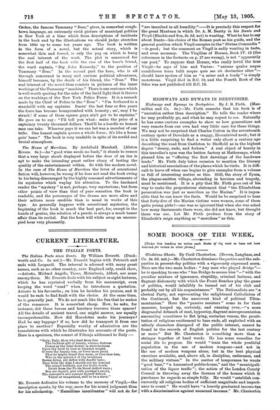HIGHWAYS AND BYWAYS IN DERBYSHIRE.
Highways and Byways in Derbyshire. By J. B. Firth. (Mac- millan and Co. 6s.)—Mr. Firth remarks that his book is of "narration rather than description." He tells the reader where he may profitably go, and what he may expect to see. Naturally he has some curious examples to show_ us how generations not very remote from our own had very little care for these things. We may not be surprised that Charles Cotton in the seventeenth century spoke of Dovedale as a craggy, ill-contrived nook; but it is a little surprising to find a writer only about a century ago describing the road from Castleton to Sheffield as in the highest degree "dreary, rude, and forlorn." A real object of beauty in this traveller's eyes was the button factory at Hathersage, which pleased him SS "offering the first dawnings of the hardware trade." Mr. Firth duly takes occasion to mention the literary and historical associations of the places which he visits. It is diffi- cult to leave off when one begins to give examples from a volume so full of interesting matter as this. Still, the story of Eyam, the plague-smitten village, abounding in heroism and tragedy, must be mentioned. It is a pity that Mr. Firth goes out of his way to make the preposterous statement that "the Elizabethan persecution was just as merciless as the Marian." It is impos- sible that he can know the facts. Would he be surprised to hear that forty-five of the Marian victims were women, some of them quite young girls ?—one was so ignorant that when she was asked how many Sacraments there were, she did not know, but thought there was one.. Let Mr. Firth produce from the story of Elizabeth's reign anything as " merciless " as this.






































 Previous page
Previous page